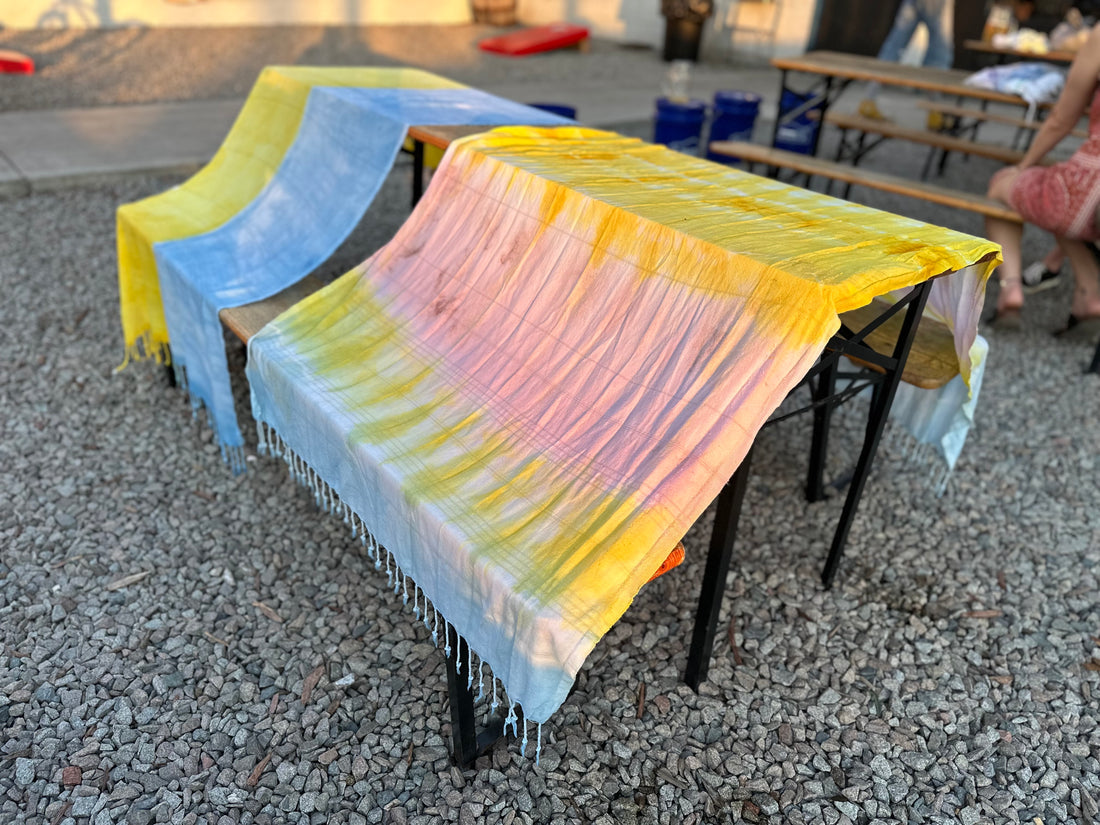Congratulations on Creating Your Unique Botanical Dyed Towel!
Here’s how to care for your beautiful creation:
1. Rinsing the Towel
Immediately After the Workshop:
- Keep your towel in the provided bag until you get home.
- Wear gloves to avoid staining your hands.
First Rinse:
- Rinse the towel under cold running water until the water runs mostly clear. Gently squeeze out excess water, but do not wring the towel.
2. Setting the Dye
Alum Pre-Soak:
- Your towel was pre-soaked in alum for 8 hours, which helps to set the dye. This process reduces the need for additional setting steps, but for extra security, you can still use a vinegar or salt bath.
Vinegar or Salt Bath (Optional but Recommended):
- To further help set the dye, you can soak your towel in a solution of either vinegar or salt.
- Vinegar Bath: Mix 1 part white vinegar to 4 parts cold water. Soak for 30 minutes.
- Salt Bath: Dissolve 1 cup of salt in a bucket of cold water. Soak for 30 minutes.
- Rinse the towel again with cold water after soaking.
3. Washing the Towel
First Wash:
- Hand wash your towel separately in cold water using a mild detergent. Avoid using bleach or strong detergents.
- Gently agitate the towel in the water for a few minutes, then rinse thoroughly with cold water.
Drying:
- Air dry your towel by laying it flat or hanging it up. Avoid direct sunlight to prevent colors from fading.
4. Regular Care
Subsequent Washes:
- For the first few washes, wash your towel separately to avoid color transfer to other garments.
- Use cold water and a gentle cycle if using a washing machine.
- Air dry or tumble dry on a low heat setting.
Special Notes for Each Dye
- Hibiscus Dye: Hibiscus can produce a range of colors from pink to deep red. It is more prone to fading, so always wash in cold water. Using vinegar to set the dye can help maintain color.
- Indigo Dye: Indigo creates deep blue shades. It may continue to release excess dye in the first few washes, so wash separately. Multiple dips can help the dye penetrate fibers deeply.
- Beetroot Dye: Beetroot produces vibrant reds and pinks. It is sensitive to heat, so always use cold water for washing and drying. A vinegar bath can help set the color.
- Purple Cabbage Dye: Purple cabbage can yield colors from purple to blue-green, depending on pH. It’s relatively stable but still wash with care in cold water.
- Turmeric Dye: Turmeric gives bright yellow hues. It can be sensitive to light, so store dyed items out of direct sunlight when possible. Cold water washes will help maintain the vibrancy of the color.
Additional Tips
- Avoid Prolonged Sun Exposure: Prolonged exposure to direct sunlight can fade natural dyes, so store your towel in a shaded area when not in use.
- Use Gentle Detergents: Opt for pH-neutral or gentle detergents to preserve the vibrancy of the dyes.
- Patch Test: If you are unsure about a detergent, do a patch test on a small, hidden area of the towel first.
FAQs
When should I take off the rubber bands?
- Remove the rubber bands after you have completed the first rinse and the water runs mostly clear. This will ensure the dye has set enough to create the desired patterns.
Do you rinse in cold water before or after the vinegar soak?
- Rinse the towel in cold water before the vinegar soak to remove any loose dye. After the vinegar soak, rinse again with cold water to remove the vinegar solution.
How long should I leave the towel in the bag before the first cold water rinse?
- Leave the towel in the bag until you get home, ideally within a few hours. The sooner you rinse the towel in cold water, the better the dye will set.
References
- Alice and Lois - How to Use Natural Dyes on Fabric: Natural Dye Tutorial
- OFS Maker's Mill - How to Dye Fabric: Natural Dyeing with Turmeric and Cabbage: Turmeric and Cabbage Dye Tutorial
- Martha Stewart - How to Make Natural Dyes From Plants and Vegetables: Natural Dye Instructions
- Natural Dyes - How to Dye With Indigo: Indigo Dye Tutorial
- Rebecca Desnos - FAQs: Washing and Caring for Plant-Dyed Clothing: Plant-Dyed Clothing Care

